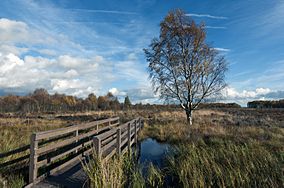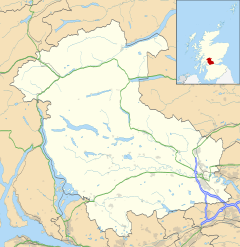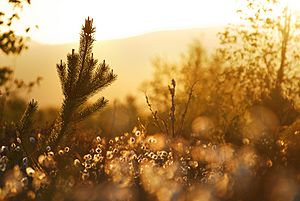Flanders Moss facts for kids
Quick facts for kids Flanders Moss National Nature Reserve |
|
|---|---|
|
IUCN Category IV (Habitat/Species Management Area)
|
|
 |
|
| Location | Stirling, Scotland |
| Area | 822 ha (2,030 acres) |
| Established | 1982 |
| Governing body | NatureScot |
| Flanders Moss National Nature Reserve | |
Flanders Moss (Scottish Gaelic: A’ Mhòine Fhlànrasach) is a very special place in west Stirlingshire, Scotland. It's a huge area of 'raised bog'. Imagine a giant, spongy cushion of plants that has grown upwards over thousands of years! This amazing natural area is managed by NatureScot.
Flanders Moss started forming over 8,000 years ago. It's now a National Nature Reserve. This means it's a super important home for many plants and animals. It's also one of the largest raised bogs in Europe that is still mostly natural.
Besides being a wildlife haven, Flanders Moss helps our planet. It acts like a giant sponge that soaks up carbon from the air. This helps to fight climate change.
Contents
What Lives at Flanders Moss?
Flanders Moss is full of life! It's made up of many different plants.
Plants of the Bog
The main plant here is a special type of moss called sphagnum moss. It's like the building block of the bog. On top of the moss, you'll find plants like heather and cotton-grass.
Even though it's a bog, some trees grow here too. You might see birch trees and Scots pine. There are also some non-native plants like rhododendron that are being carefully removed.
Many plants at Flanders Moss are unique. They are specially adapted to live in wet, boggy places. Look out for:
- Round-leaved sundew: A tiny plant that eats insects!
- Cranberry: Yes, the same fruit you might eat!
- Bog asphodel: A plant with bright yellow flowers.
- White beak-sedge: A grass-like plant.
- Bog rosemary: A rare plant with pretty pink flowers.
Animals of the Bog
Flanders Moss is home to many different animals.
Insects and Birds
The bog is a fantastic place for insects, especially moths. Over 200 types of moths have been found here! Some are very rare. Many insects live among the trees and bushes.
Many birds also live or visit Flanders Moss.
- In the open bog areas, you might see snipe, curlew, and stonechat.
- In the wooded parts, look for tree pipit, cuckoo, and wood warbler.
- In winter, large birds like whooper swans and greylag and pink-footed geese come to visit.
- You might even spot birds of prey like hen harriers, short-eared owls, and ospreys flying overhead.
Mammals and Reptiles
Larger animals also visit the reserve.
- Red and roe deer sometimes wander through.
- Otters use the water channels to move around.
- The moss is also home to many reptiles and amphibians. You might see adders (a type of snake), common lizards, and slow worms.
A Look Back in Time: History of Flanders Moss
Flanders Moss has a long and interesting history. People have been connected to this area for thousands of years.
Ancient Times
Long ago, during the Bronze Age and Roman times, people lived near the moss. Old objects like a Bronze Age cauldron have been found here. This shows that the area was important even then.
Changing the Land
In the 1700s, people tried to drain parts of the moss. They wanted to turn the wet land into farmland. A lawyer named Henry Home, Lord Kames encouraged this. But luckily, large parts of Flanders Moss survived these changes.
Later, in the 1880s, a railway line was built through one part of the moss. In the 1970s, more of the moss was drained. Trees were planted there for wood. However, much of this forest is now being removed. The goal is to bring the moss back to its natural, wet state.
Protecting and Managing Flanders Moss
Flanders Moss is a very important natural area. It has special protections to keep it safe.
Special Protections
It is a Site of Special Scientific Interest. This means it's recognized for its unique plants, animals, and geology. It's also part of a larger "special area of conservation" called the Flanders Mosses SAC. This area includes other nearby bogs.
NatureScot (which used to be called Scottish Natural Heritage) bought rights to the site in 1995. They work to protect and manage the reserve.
How the Moss is Managed
NatureScot owns some of the reserve and works with other landowners for the rest. Their main goal is to make the moss wet again. In the past, ditches were dug and peat was removed, which dried out the bog.
Now, NatureScot is:
- Building dams in the old ditches to raise the water level.
- Removing trees and non-native rhododendron that dry out the bog. They want to keep open, treeless areas.
- Letting sheep graze in some areas. This helps stop new trees from growing.
All these actions help the bog become healthy and wet again. This is good for the special plants and animals that live there.
Visiting Flanders Moss
Around 8,000 people visit Flanders Moss each year. It's a great place to explore nature!
There's a car park on the eastern side of the reserve. From there, you can find a viewing tower. This tower gives you amazing views over the vast bog. There's also a short walking trail, about 900 meters long.
NatureScot plans to create even more paths. They want to offer longer walks and access to other parts of the moss. They might even connect the reserve to the nearby village of Thornhill. This would make it even easier for people to enjoy this incredible natural wonder.




